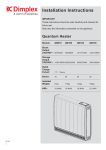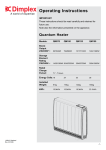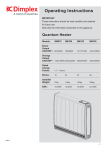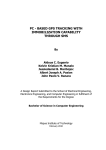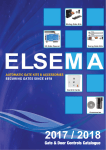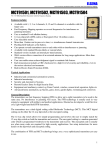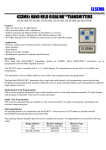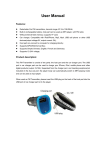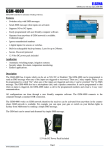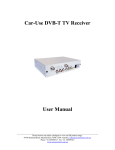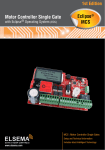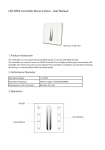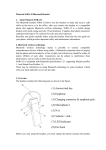Download 434MHz Transceivers
Transcript
ELSEMA 434MHz Transceiver with Optically Isolated Inputs and High Power Relay Outputs 434MHz Transceivers MCTR43401: 1 Optically Isolated Input and 1 Relay Output MCTR43402: 2 Optically Isolated Inputs and 2 Relay Outputs MCTR43404: 4 Optically Isolated Inputs and 4 Relay Outputs Features • Wide supply connection, 10 - 28 Volts AC or DC • Reverse polarity protection, EMI, surge and transient protection • Up to 4 input channels with simultaneous channel transmission • Up to 4 relay outputs with simultaneous channel reception • Over 800 metres operating range with repeater mode • User selectable relay modes, momentary or latching • Easy connection using pluggable terminal blocks • Crystal controlled for high stability and accuracy • On-board LED’s for the Inputs and Outputs • Four user selectable transmission modes o Simple transmit and receive o Transmit and receive with return signal acknowledgment o Repeater with one-way communication o Repeater with two-way communication Applications Process controls in factories, warehouses and farms Water or sewerage tank level monitoring Equipment and machinery control Irrigation and pump controls Security Description The transceiver operates in the 434MHz frequency band with 10mW of RF power. Using Elsema’s ANT433M antenna it is possible to get up to 800 metres line of sight communications. This range can be doubled by configuring an extra MCTR43404R as a repeater. An Elsema 434Micro antenna is provided for free with all MCTR series transceivers and can be used for testing short range applications less than 80 metres. Supply The transceiver power supply can be AC or DC. The power supply has built-in protections against EMI noise, surges and transients. Even if there is a power failure on one transceiver the built-in handshake acknowledgments will ensure that the transceivers inputs and outputs are returned to the same state as before the power failure. Solar Power: Use one of Elsema’s 10 Watt or 20 Watt Solar Panels with the BACH charger to supply the transceivers with solar and battery power. 1 ELSEMA 434MHz Transceiver with Optically Isolated Inputs and High Power Relay Outputs Products in the Range MCTR43401R 1 Input / Output MCTR43402R 2 Inputs / Outputs MCTR43404R 4 Inputs / Outputs MCTR43401RE MCTR43402RE MCTR43404RE Transceivers in a weatherproof Case SP10-10 Watts SP20-20 Watts 20W Solar panel Signal Strength Indicator The 1 and 2 channel transceivers have three orange SS LED’s on the board. These orange LED’s indicated the signal strength. 3 LED’s on 2 LED’s on 1 LED on -70dBm -80dBm -90dBm Strong Signal Good Signal Signal OK Reliable Operating Conditions Reliable Operating Conditions Operating Conditions Ok Noise Strength Indicator If more than 1 SS LED is “ON” without a valid transmission this indicates that there is noise on the frequency selected. Change dipswitch 1 and 2 of the 12-way dipswitch to select a different frequency. Sw1 Off On Off On Sw2 Off Off On On Frequency (MHz) 433.3020 433.9164 434.5308 433.3020 Inputs and Outputs Inputs There are up to four normally open inputs. When these inputs are closed (Shorted to Ground/Negative) the signal is transmitted. Output Modes Relay output on the receiver can function in either momentary or latching mode. By default the mode is set to momentary. Modes selectable from the 4-way dipswitch. Dipswitch 1 corresponds to relay channel 1 and dipswitch 2 corresponds to relay channel 2 and so on. Factory Default = Momentary Momentary - Output is active for as long as the transmitter button is pressed. This is a standard mode on most automatic gates or garage door openers. Latching 2 - Output remains active until next press of the transmitter button. Similar to switching "on" and "off" a light. ELSEMA 434MHz Transceiver with Optically Isolated Inputs and High Power Relay Outputs Customised Software Custom output modes can be programmed to do special functions. Call Elsema for more details. Input and Outputs LED’s Flashing Orange If the Input and Output LED’s are flashing orange this indicates that something has failed in the RF link, e.g. broken antenna. 12-Way Dip Switch Coding 1. Set a random code on one of the transceivers 12-Way dip switch by flicking the switches "On" or "Off". (DO NOT USE THE DEFAULT FACTORY SETTING FOR THE 12-WAY DIP SWITCH AS THIS IS A COMMON CODE) 2. Set the same setting on the other transceivers 12-way dip switch. 3. Press the test button on one of the transceivers to test the other transceivers relay output 4. Relay should activate. Do not use all “off” on the 12-way dip switch. This is used for factory test mode. LED colours Green LED indicates signal transmission Red LED indicates that a relay has been activated. Orange LED flashing indicates RF link failed (Communication failure) 3 ELSEMA 434MHz Transceiver with Optically Isolated Inputs and High Power Relay Outputs Transmission Modes The transceivers can be user configured to four different transmission modes. Mode 1 Simple transmit and receiver Transceiver is used to send the signal one-way to activate a relay. Used for simple on/off functions. See diagram below. Both transceivers should be set to Mode 1 4 ELSEMA 434MHz Transceiver with Optically Isolated Inputs and High Power Relay Outputs Mode 2 Transmit and receive with acknowledgment Transceiver is used to transmit a signal to another transceiver with a return acknowledgment. If a transceiver receives a valid signal it will return a signal back to the first transceiver and a relay and LED is turned “On”. This LED will indicate which relay is “on”. See diagram below. With mode 2 you will need to set the momentary or flip flop mode the same in both transceivers and one of the transceivers should be set as a Master and the other transceiver to a Slave. Remove the Slave jumper to setup as a slave. Both transceivers should be set to Mode 2. 5 ELSEMA 434MHz Transceiver with Optically Isolated Inputs and High Power Relay Outputs Mode 3 Repeater with one way communication The repeater mode is used to increase the transmitting range. The repeater will receiver the signal and then re-transmits the original signal on a different frequency. Re-transmitting the signal on a different frequency allows you to chain link up to 2 repeaters. To chain link repeaters the frequency needs to be correctly set on each repeater. See the frequency table below. Only signals that match the repeaters 3 to 8 dip switches will be repeated. Sw1 Off On Off On 6 Mode 1, 2 & 4 Sw2 Frequency (MHz) Off 433.3020 Off 433.9164 On 434.5308 On 433.3020 Mode 3 (Repeater) Receiving Frequency (MHz) Transmitting Frequency (MHz) 433.3020 433.9164 433.9164 434.5308 434.5308 433.3020 433.3020 433.9164 ELSEMA 434MHz Transceiver with Optically Isolated Inputs and High Power Relay Outputs Mode 4 Repeater with return acknowledgment The repeater will receive the signal and then re-transmits the original signal on the same frequency. The final transceiver will send back a signal, via the repeater to indicate which output is activated. Only one repeater can be used in this mode. With mode 4 you will need to set the momentary or flip flop mode the same in both transceivers and one of the transceivers should be set as a Master and the other transceiver to a Slave. Remove the Slave jumper to setup as a slave. Both transceivers should be set to Mode 2 and the repeater to Mode 4. Slave Jumper Remove the jumper on the pins labelled SLAVE. This will setup the transceiver to a slave. See picture below. 7 ELSEMA 434MHz Transceiver with Optically Isolated Inputs and High Power Relay Outputs Changing the Transmission Modes On the back of the transceivers there are 2 pairs of square pads. An outer and an inner pair of pads that are used to change the mode of the transceiver. See the picture below. Transmission Mode 1: No link on any of the pads sets both transceivers to Mode 1. Transmission Mode 2: Outer pads shorted sets both transceivers to Mode 2. Transmission Mode 3: Inner pads shorted sets the transceiver to Mode 3. Transmission Mode 4: Both Outer and Inner pads are shorted sets the transceivers to Mode 4. Warning: These pads are electrostatic sensitive. Earth yourself and the soldering iron on a metal surface before soldering the pads. Failure may result in the IC being permanently damaged. Operating Frequencies Dipswitch 1 and 2 set the operating frequency. Since the frequencies are all within the 434MHz band it is not recommended to operate a second installation within a 300 metres radius of the first installation. Sw1 Off On Off On Sw2 Off Off On On Frequency (MHz) 433.3020 433.9164 434.5308 433.3020 Customised Software Customer specific programs can be written to do special functions. Call Elsema for more details. Antenna The transceiver has a 50 ohms SMA connector to allow a proper 434MHz antenna to be connected. Elsema stocks the ANT433M or ANT433S, 434MHz antennas. Case The transceivers can be supplied with an IP66 rated case for outdoor and indoor use. The product part number ending in “E” includes the IP66 rated cases. MCTR43401RE, MCTR43402RE and MCTR43404RE. 8 ELSEMA 434MHz Transceiver with Optically Isolated Inputs and High Power Relay Outputs Application Notes Here a security guard is monitoring a transceiver that has three lights and a buzzer connected. The three lights represent three different locations and the buzzer alerts the guard that an alarm has been activated. At each of the three locations you have a transceiver. At these locations you wire a single button that will activate two inputs in parallel, one for the light and the other for the buzzer. This signal will be transmitted to the security guard house. 9 ELSEMA 434MHz Transceiver with Optically Isolated Inputs and High Power Relay Outputs Technical Specifications Supply Voltage 10 - 28 Volts AC or DC Can use Elsema AC power supply PP12 or PP24 Solar Panel Backup SP10 for 10 Watt Solar Panel, SP20 for 20 Watt Solar Panel Battery Backup BACH12 for 12 volt charging or BACH24 for 24 Volt charging. Current Consumption 27 mA stand by at 12VDC, 45 mA with 1 relay “On” or 100 mA with 4 relays “On” Frequencies 433.3020, 433.9164 or 434.5308 MHz Operating Temperature -20°C to 70°C R.F. Output Power 10mW into 50 ohms SMA connector Sensitivity 2uV (For output to switch on) Type of Demodulation Frequency Modulation (FM) ID System Setting 12-way dip switch Inputs Pluggable screw type terminal block. Inputs are Normally Open (NO) Outputs Change over relay outputs rated at 8 Amps 240VAC Relay Contacts Common (C) , Normally Closed (NC) & Normally Open (NO) LED’s Dual coloured LED’s to indicate inputs and outputs status Antenna Elsema type ANT433M. A 433Micro antenna is provided for free with each transceiver for short range application testing of less than 80 metres. Mounting QM150 Quick Mount Mounting hole size 3.97 mm or 5/32" Case Optional Plastic Case with IP66 rating Dimensions 130 x 70 x 26 mm Weight 117 grams Operating Range Over 800 metres operating range with repeater mode 10 ELSEMA 434MHz Transceiver with Optically Isolated Inputs and High Power Relay Outputs Block Diagram MCTR43401R MCTR43402R 11 ELSEMA 434MHz Transceiver with Optically Isolated Inputs and High Power Relay Outputs MCTR43404R 12 ELSEMA 434MHz Transceiver with Optically Isolated Inputs and High Power Relay Outputs MCTR43404R, 12 or 24 VAC/DC Applications 13 ELSEMA 434MHz Transceiver with Optically Isolated Inputs and High Power Relay Outputs MCTR43404R, 110 or 240 VAC Applications Elsema Pty Ltd 31 Tarlington Place, Smithfield, NSW 2164 Ph: 61 2 9609 4668 Fax: 61 2 9725 2663 Website: www.elsema.com Distributed by: User Manual 2nd Edition October 2011 14
















